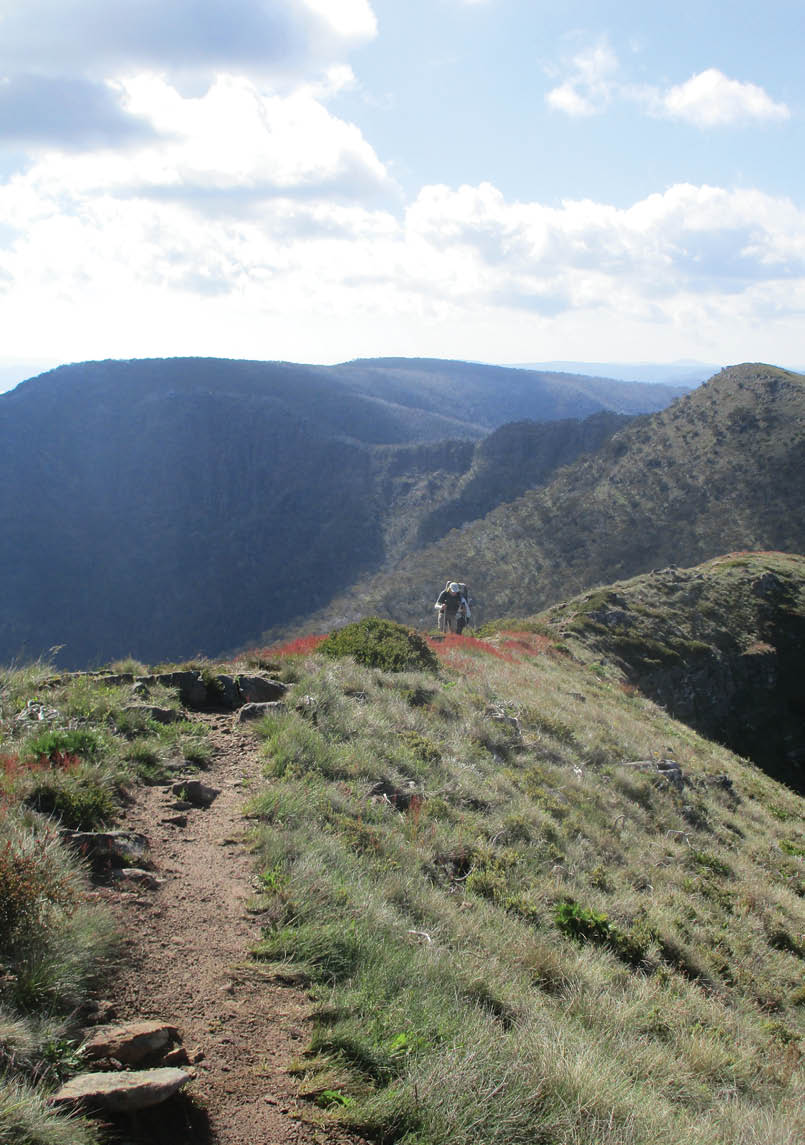


In the last few years I have walked over 2000 kilometres on some of Australia’s long-distance tracks. These include tracks in New South Wales, Victoria, South Australia, Queensland, Northern Territory and the ACT. My walking experience in Western Australia is confined to off-track walking in the Kimberley and I have not undertaken a long-distance walk in Tasmania. I have also completed long-distance walks in New Zealand, Italy, Japan and Scotland.
Traversing the Crosscut Saw, Alpine NP along the Australian Alps Walking TrackAll pictures by David Bell

Long-Distance Walking Tracks in AustraliaHow We Can Make Them Better
David Bell

50 | BWA August 2019
So I have accumulated a fair bit of experience with long-distance walking and I feel somewhat qualified to offer a few suggestions as to how to make long-distance tracks a better experience for the walker.
Why do I feel that improvements are needed? Well because I have a real sense that the future of some of these long-distance tracks is under threat. This is not from any deliberate intention to close them down or make them unwalkable, but rather just from benign neglect or an unwillingness to commit sufficient resources to properly maintain them. Also, park agencies are often starved of funds with too many competing priorities, sometimes driven by political direction rather than on merits.
Part of the problem is that, in Australia at least, we lack a long-standing culture of independent long-distance walking. It is not something that Australians do and those that do it are regarded as eccentrics or oddballs. Other countries seem to do it better and there is more recognition that long-distance walking is a legitimate and worthy recreational activity to undertake.
But that is just my opinion. Readers are welcome to disagree. So firstly, some definitions.
Long-distance tracks may be defined as anything over 80 kilometres in length, that is, a track that takes at least 3-4 days to complete. These tracks cannot be done in a weekend, at least by those of average fitness. Long-distance tracks include
the very long such as the Heysen Trail (1200 kilometres or so);
long such as the Australian Alps Walking Track (650 kilometres); and
not so long such as the K'gari (Fraser Island) Great Walk (90 kilometres).
My remarks in this article are also primarily directed at what I call the independent, do it yourself walker. Or the “end to ender” or the “through walker”, people who carry their own gear and food and navigate without the assistance of a guide.
I am aware that many long-distance Australian walks permit commercial groups. However, I am not primarily addressing their needs although I do recognise that some of the issues I raise below are also relevant to the commercial sector.
So what follows below are my top eleven topics that track managers or owners should address. In my view they would make the track experience of end to enders, through walkers or independent walkers (whatever you want to call them) more fulfilling, more straightforward, more enjoyable, more viable and, above all, safer.
They are not listed in any priority order. Readers can decide themselves which topics are more important for them. I expect there will be other topics which I have left out here. Let the conversation begin!
1 Understand who are the intended users of the trackIf it is the intention that a track will cater for a variety of walkers then the needs of these walkers need to be understood. A day walker will have different needs to the multi-day or end to ender. One of the chief differences is that day walkers can carry their water in. Longer-distance walkers do not have that luxury. They have to find water along the way, which may be a problem in drier areas.
2 Establishing and maintaining campsitesSome walkers like to camp in the bush with zero or minimal facilities, and good for them. While I like bush camps, many tracks, especially those that carry a fair bit of foot traffic, need formal campsites. In some places these need a water supply such as a tank. Some places may also require a toilet. Circumstances will vary with each track.
Closed campsites are a problem for the long-distance walker
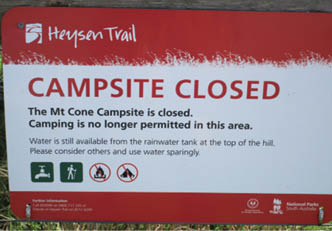
“... I have a real sense that the future of some of these long-distance tracks is under threat.
BWA August 2019 | 51

Finding a place to camp may also be a problem for tracks with a mix of public and private land. Land ownership may change and a new property owner may be hostile to walkers crossing their land. Not everyone has the capacity (or inclination) to walk 35 or 40 kilometres in a single day and the closure of a campsite presents yet another hurdle to the long-distance walker.
Consequently, track managers need to be more diligent in replacing closed campsites with new ones. The ideal for a long-distance track should be a campsite with access to potable water every 20-25 kilometres or so.
3 All tracks need friends – literallyTracks need the support of government agencies. No question about this. However, tracks also need the support of volunteers to assist in planning and maintaining tracks. For example, the McMillans Track in Victoria would not exist without the volunteer efforts of the Ben Cruachan Walking Club to bring the track back into existence and to help with its ongoing maintenance. Similarly, the Friends of the Heysen Trail in South Australia perform a critical role.
My experience is that where a track lacks a friends group, then the standard of the track is diminished. This is particularly apparent in NSW where there appears to be less of a volunteer culture in maintaining long-distance tracks than in other states.
Here are some links to Friends groups. Not all are represented here and it is worth exploring the various state-based bushwalking organisations to find further links to clubs and volunteering opportunities. Start with the Bushwalking Australia website.
Friends of the Cape to Cape Track
Friends of the Great South West Walk
4 You can’t manage if you don’t measureIt never ceases to amaze me how little information we have on who is doing long-distance walking. Walker registers do exist but they are not always present and by no means are they sufficiently common to adequately record usage. There appears to be little use of the internet or social media to track numbers or intentions in relation to tracks. Every track should have a web page and the capacity to interact with it. This includes making it easy for walkers to report problems with tracks such as missing markers or changes in track conditions.
The Bushwalk.com forum is a useful place to post information and questions about tracks and it includes several discussion threads about long-distance tracks such as the AAWT. This forum style could be used for the webpages of specific tracks and the administrators of these sites should enhance their capability to host discussion threads.
5 Integrate tracks into local economiesMy last long-distance walk lasted three weeks and involved two rest days, one week apart. The party was small (three people) but I calculated that the party spent nearly $1000 collectively in those two locations on accommodation, meals, food re-supply and replacement equipment items. Yet my experience is that local tourism bodies are largely ignorant of the economic benefits of the long-distance tracks that pass through their areas. There may be a map or two in the information centre but the staff usually know little if anything about the tracks.
Local councils, tourism bodies and business chambers should do more to incorporate long-distance tracks into their economic development strategies and other marketing initiatives.
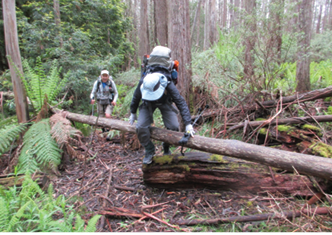
Reporting track maintenance issues such as fallen timber needs to be simple
“Not everyone has the capacity (or inclination) to walk 35 or 40 kilometres in a single day ...
52 | BWA August 2019
6 Promotion to increase these economiesIf properly promoted, these tracks could also make a small but important contribution to local economies. People involved in tourism marketing, transport and hospitality should have an awareness of local tracks, who the users of these tracks are and what types of services they are interested in.
One further point is that where a track crosses a main road, then erect a sign to indicate the track crossing. Apart from the safety considerations, it also advertises the track to passing drivers. One of the best examples I’ve seen is where the Great North Walk in NSW crosses the old Pacific Highway at Charlestown. There is a great big sign saying ‘Great North Walk’. Hard to miss.
7 End to end walkers don’t only go in the one directionTrack way marking and information sources should not assume that walkers will only be going in one direction. There is no excuse for having only one marker on a post or gate. Walkers coming the other way will miss it. Similarly, guidebooks should consider walkers going in different directions. The book by Chapman et al on the Australian Alps Walking Track does a good job in presenting information for walkers either heading north or south.
8 Walker safety is importantMy personal gripe is with roads. I never appreciate being forced to walk along a bitumen winding road with a missing or narrow shoulder. In wet or foggy conditions, it can be dangerous. If track planners have no alternative to a road then at the very least, they should install a shoulder to walk along.
9 Someone needs to "own" the trackIt can very frustrating to come across some problem with a track (missing track marker or obstacle such as fallen timber) and then spend a lot of time trying to find out where the problem should be reported. Many tracks cross multiple jurisdictions and, in some cases, they lack an “owner”, someone who can be the first port of call to report a problem. Government departments and agencies can be very difficult to navigate. Reporting a problem would also be made easier if the track web page had an entry point to communicate this information. But many track web pages do not have this facility.
10 Have proper beginnings and endingsStarting and finishing a long-distance walk is a moment to celebrate (or commiserate). There should be a marker where people can assemble and take photos. Track heads should reflect the task completed or the task ahead, irrespective of the direction travelled or to be taken.
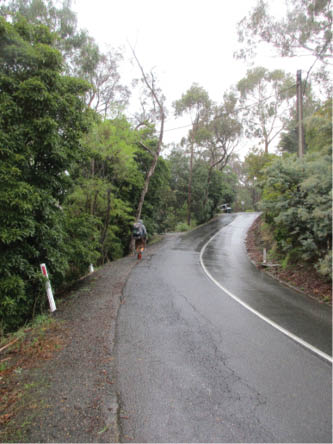
Roads like this in the Adelaide Hills with missing or narrow shoulders are dangerous
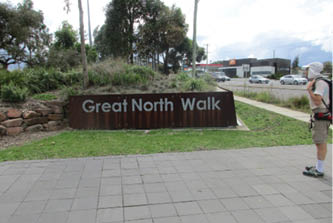
Road crossing - Great North Walk, NSW
“Reporting a problem would also be made easier if the track web page had an entry point to communicate this information.
BWA August 2019 | 53
Unfortunately, some Australian tracks have a distinctly underwhelming appearance where they begin or end. The best example of a track finish I have seen is where the West Highland Way finishes (at least for most walkers) at Fort William in Scotland. The statue of the weary walker rubbing his foot is a magnet for people to linger and celebrate. We need similar installations here.
Yes, I realise a sculpture can be expensive but some sort of installation (even a plaque) is better than nothing. Installations can also provide information about the history of the track and, if interesting enough, installations can also generate publicity via social media.
11 Bushwalkers are usually friendly – engage with themIt would be great if government agencies responsible for tracks regularly engaged with the bushwalking community about the management of long-distance tracks.
By community I mainly mean clubs and their state-based federations or associations. This communication would not just be about the management of existing tracks but could also include proposals for new tracks or extending existing ones.
So those are my 11 topics. I have probably forgotten others but this is a start. Let us hope it leads to a better future for our long-distance walking tracks.
ReferenceJohn Chapman, Monica Chapman and John Siseman 2009 Australan Alps Walking Track 4th Edition.
David has been bushwalking most of his adult life. He loves the outdoors, in particular long-distance walks. There are places that are remote and wild and it is a privilege to be able to visit them. He recently decided to write more about these places, hopefully encouraging others to also visit them or, if not, to at least enjoy reading about these places. He is a member of three bushwalking clubs and is involved in several campaigns to protect our national parks.


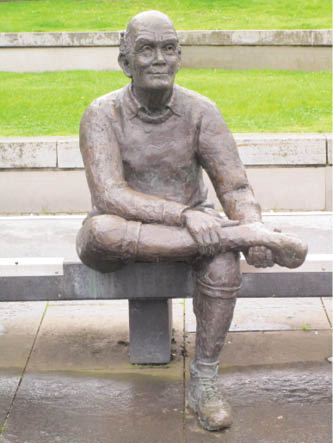
Statue of weary walker, West Highland Way, Scotland
“It would be great if government agencies responsible for tracks regularly engaged with the bushwalking community ...
“... some Australian tracks have a distinctly underwhelming appearance where they begin or end.
54 | BWA August 2019